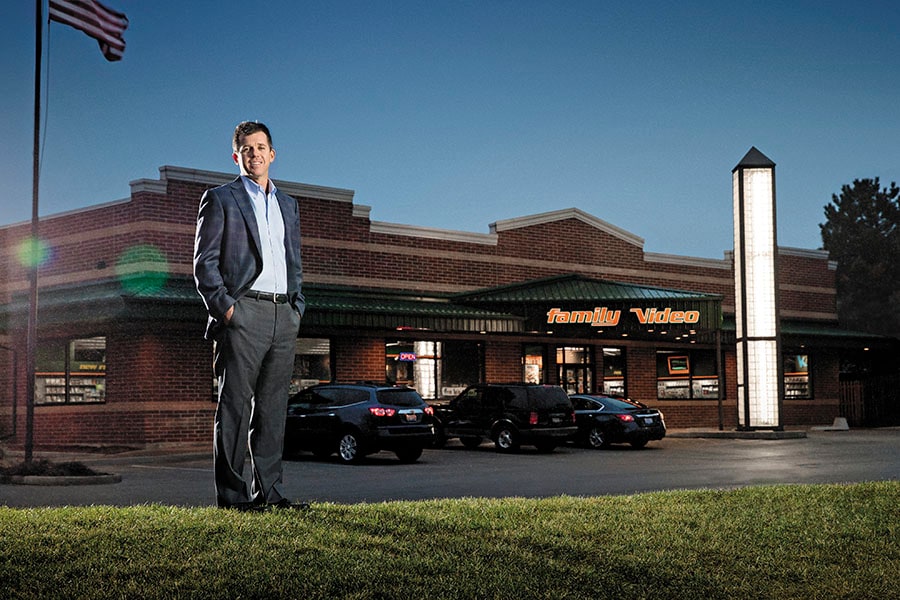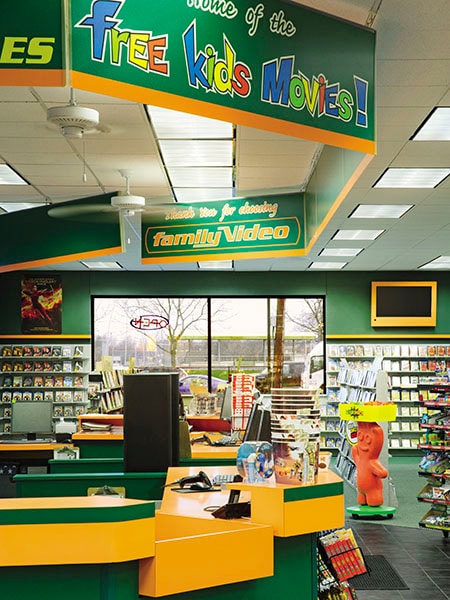
The last video chain: The inside story of Family Video and its $400 million owner
Five years after Blockbuster failed, Keith Hoogland still has 750 Family Video outlets. His scrappy model has made him a $400 million fortune
 Survivor: Keith Hoogland, owner of Family Video, says the conventional wisdom about why other video chains failed is wrong
Survivor: Keith Hoogland, owner of Family Video, says the conventional wisdom about why other video chains failed is wrong
Image: Jamie Kripke for Forbes
In Granite City, Illinois, a sleepy town of 29,000 where the laws of time seem not to apply, a just-opened Family Video storefront beckons customers with signs promoting the latest Hollywood blockbusters. Inside, long rows of DVDs line aisles festooned with placards offering two movie rentals for a dollar, and at the register, a smiling cashier greets regulars by name.
Yes, the year is 2017—and the Granite City store is defying odds, humming along in an industry most people assume has ceased to exist. In fact, the business is “doing gangbusters”, says its owner, Keith Hoogland, who has grown Family Video into a sprawling chain of 759 locations spread across 19 states and Canada, with a concentration in the Midwest and rural America and with more grand openings on the way. “I’m 57 years old,” says Hoogland, “and this is the most exciting time I’ve ever had in my life.”
Operating from an unassuming two-storey office building in Glenview, Illinois, 20 minutes northwest of Chicago, Family Video rents DVDs to loyal customers enamoured with its traditional, small-town feel. Last year, the company pulled in an estimated $400 million in revenue, more than 10 percent of which fell to the bottom line. Started by his father in 1978, the chain has grown dramatically under Hoogland’s watch, and he holds roughly a 70 percent stake, with the rest split among family members. Revenue has flattened and even fallen slightly in recent years, but the decades of growth have afforded Hoogland a remarkable lifestyle: Two corporate planes, multiple luxury properties and an estimated net worth north of $400 million. Sitting at his office desk, he proudly displays photos of a vast, ten-bedroom compound he recently commissioned in Turks and Caicos, alongside what he calls the “No 1 beach in the world”.
Brimming with energy, Hoogland tries to explain how all of this is possible. After all, it’s been more than five years since the big video chains, Blockbuster and Movie Gallery, filed for bankruptcy, unable to compete in the digital age. At its peak, Blockbuster operated more than 9,000 outlets, bringing in $6 billion in annual revenue. Today, just a few dozen of its stores remain.
Hoogland insists that Family Video had no trouble competing with bigger players, and he sees few parallels between those companies and his own. “Everybody thought the reason they went away was because of digital,” he says. “But in reality that wasn’t the case. They weren’t very well-run businesses. They had a lot of debt, leases that were poorly negotiated, and they also were sharing revenue with studios quite a bit. They made a lot of poor decisions.”

Back to the future: Family Video isn’t just about nostalgia—it often gets new releases before online services like Netflix and Amazon do
Family Video has taken a different approach. Instead of accepting discounted movies in exchange for agreements to split revenue, as Blockbuster did, it has opted to buy films outright and keep 100 percent of rental proceeds, which has paid off in the long run. Hoogland has also kept his stores entirely company-owned, and he keeps costs down by making many of the items needed for new locations in-house—everything from shelving to point-of-sale software. Most important, though, the company owns just about all the real estate underpinning its stores. As a result, Hoogland has been able to adapt now that sales are beginning to fall. He has shrunk the square footage of many of the video stores, put up drywall and leased out space to other companies, like Subway and H&R Block.
He has also experimented with ventures of his own, using his properties to launch 11 fitness centres, an electronics-repair chain called Digital Doc and 149 Marco’s Pizza franchises (making him the brand’s single largest franchisee). The businesses are managed under the umbrella of Highland Ventures—“Hoogland” means “Highland” in Dutch. Family Video still accounts for nearly 90 percent of the parent company’s $450 million in annual revenue, and Forbes estimates the chain’s real estate is worth as much as $750 million.
The origins of Family Video can be traced to 1946, when Keith’s grandfather Clarence, a salesman, started a distribution business, Midstates Appliance & Supply Co, in Springfield, Illinois. Seven years later, Keith’s father, Charlie, took over. In the 1970s the company started getting squeezed: Its core customers, mom-and-pop appliance shops, were going out of business, and its main suppliers were forgoing distributors in favour of direct sales. In 1978, left with just a few pieces of real estate and an oversupply of videocassette tapes, Charlie launched the Video Movie Club of Springfield, a precursor to Family Video and one of the first movie-rental stores in the US.
Even then Charlie was not convinced the business would last. While the cassettes he rented out were high tech for the time, he feared newer innovations would soon undermine his sales. To hedge against such uncertainties, Charlie, figuring the real estate under the stores would always be valuable, decided to repay the mortgages on his first locations within five years—a policy the company has maintained ever since.
As it turned out, Charlie’s initial worries proved unfounded—VHS tapes dominated the rental space for decades—but the company’s early caution set the course for its expansion strategy: By the time Keith entered the business in 1983 at the age of 23, his father was pushing to conquer rural markets, believing that well-capitalised competitors would hold the advantage in major cities.
Today, Family Video is the dominant player in rural America, where 90 percent of its stores reside. There, many customers either have limited access to high-speed internet or are reluctant to adopt alternatives like Redbox, Netflix and Hulu. Inside the stores, employees greet every customer who walks through the door, often by name; kids’ movies are always free to rent; and late fees are negotiable. When new locations open, the ribbon-cutting ceremony is a community affair, complete with face-painting stations, promotional giveaways and snow cone machines. Almost all of Hoogland’s top executives started in one of his stores, and many employees have enjoyed benefits like full-tuition scholarships for their children.
One result is that Family Video outlets have become gathering places in many smaller towns. “If you walked in on a Friday or Saturday night, you’d be amazed at how busy our stores are,” Hoogland says. “People like the experience. It’s kind of like a local coffee shop.”
But Family Video has more going for it than nostalgia. Most significantly, copyright agreements on motion pictures are often less stringent for physical videos than for streamed content, meaning that rental stores frequently have access to new releases weeks, or even months, before Netflix or Hulu get them. “Movies are still unique in that renting them in a store and on a disc is really the only way to circumvent rights issues that exclusively lock up content,” says Tony Wible, technology and media analyst at Drexel Hamilton.
That advantage has helped Family Video attract business outside of broadband deserts and beyond ageing loyal customers. Its typical patron is 35 to 45 years old, but Hoogland believes younger customers are coming in greater numbers. The chain’s average store still pulls in roughly half a million dollars in annual revenue.
Eager to maintain momentum, Hoogland continues to work seven days a week, though he’s been cutting back lately to make room for his children to enter the business. So far, just one of his six kids, his eldest son, McLain, a former marine, works at Highland Ventures. McLain runs a few of the company’s smaller projects, including Highland Pure Water & Ice, which sells purified water out of kiosks next to Family Video branches located in communities with poor infrastructure.
Keith acknowledges that his movie rental empire won’t last forever, but he sees Family Video as an easy way to expand his real estate portfolio, which has no obvious expiration date. The formula is simple: Open a store, use rental sales to pay off the mortgage and hold on to the property. “In five years, we’ll still be here,” he says, grinning. “We’re going to hang on for quite a while.”
(This story appears in the 30 November, -0001 issue of Forbes India. To visit our Archives, click here.)




